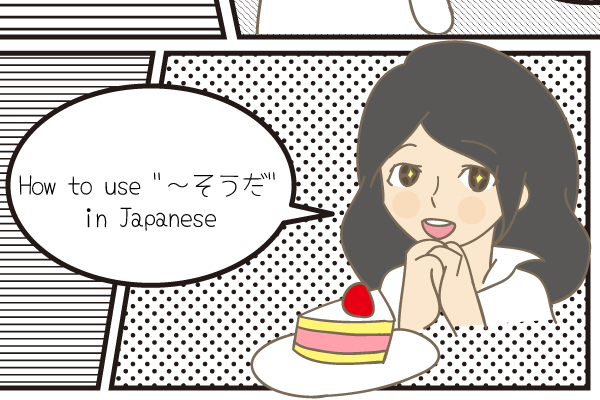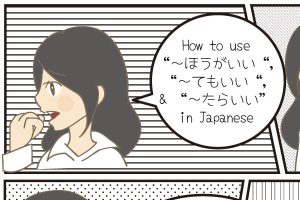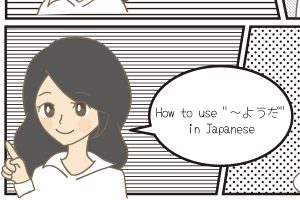How to use “~そうだ” in Japanese
Last week you learned how make suggestions or give advice in Japanese, using various expressions such as “~ほうがいい”, “~てもいい”, and “~たらいい”.
In this lesson, Shiho introduced the expression “~そうだ”, which you can use to describe the condition of people, things or situations.
[About “~そうだ”]
There are several ways to express assumptions or describe imagined or possible situations in Japanese. One of these expressions is “~そうだ”. Other than “~そうだ”, you can also use “~ようだ”, “~らしい” or “~そうだ” (another version of “~そうだ” used to convey hearsay), which we will take a look at in further videos and aritcles to come.
A lot of them are very similar, so let’s study these expression thoroughly so that you can learn to differentiate between them and use them correctly!
[Using “~そうだ” to express an indication]
There are two different ways you can use “~そうだ” to express perceived situations. One of them is using it to look at a situation, make a conclusion as to what seems to be going on and expressing that using “~そうだ”.
For example, let’s say you are looking at a baby. The baby looks terribly tired, so you conclude that the baby will most likely fall asleep very soon. Then you could say:
(赤ちゃんは)もう寝そうですね
(The baby) looks like it’s about to fall asleep.
[Using “~そうだ” to express a possibility]
Another way to use “~そうだ” is to express the possibility of an event to happen.
Let’s say you are a student. You and all the other students think that the lessons given by teacher A are ridiculously boring. All of you are about to attend one of teacher A’s lectures. Now you could say:
みんな授業中に寝そうだよね
Everyone will probably fall asleep during the lecture.
[How to differentiate between indication & possibility]
Now, let’s introduce a little hint that will help you differentiate between using “~そうだ” to express an indication or a possibility.
First of all, you cannot use “~そうだ” with nouns.
When using “~そうだ” with adjectives (both i- and na-adjectives), it always expresses an indication. For example:
このケーキは美味しそうだ。
This cake looks delicious.
彼はいつも暇そうだ
He always looks free.
In these cases you look at the cake and from its appearance, you come to the conclusion that it looks delicious. Looking at the boy, you also look at him and his current situation and then deduct he always looks like he has nothing to do.
When using “~そうだ” with verbs, that can express both an indication and a possibility. For example:
愛さんが倒れそうだ。
Ai looks like she’s about to faint.
This sentence indicates that the speaker looked at Ai, who looks really sick and can barely walk straight, deducting that she might actually faint.
餅が喉に詰まって苦しい。死にそうだ。
The rice cake got stuck in his throat and he’s in pain. He looks like he might die.
This sentence shows the possibility that the person with the rice cake in their throat might actually die, since they are in pain and can’t breathe.
[Using “~そうだ” with different grammatical structures]
You can also change “~そうだ” to “~そうな” or “~そうに” to implement it in different grammatical structures.
“~そうな” can be placed in front of nouns to describe the noun in a sentence. Example:
美味しそうなケーキがある。
There is a delicious-looking cake.
It’s good to remember that the meaning of the sentence does change depending on whether you include “~そうな” or not. (If you didn’t include it but wrote “美味しそうなケーキがある。”, that would mean “There is a delicious cake”, meaning the speaker doesn’t assume or deduct that the cake is delicious but actually knows it.)
Let’s look at another example that will make this clearer:
1 彼は面白い顔をしている。
1 He has a funny face.
2 彼は面白そうな顔をしている。
2 He looks amused.
The first sentence means whoever we are talking about actually has a funny face, while the second sentence means that he has an amused look on his face.
“~そうに” can be placed in front of verbs to describe them. For example:
彼は何でも美味しそうに食べる。
He eats everything as if it was delicious.
[Using “~そうだ” in past and interrogative entences]
“~そうだ” can be used for past and present statements and to express possibilities or to voice deductions. In addition it can be used to make interrogative sentences. Here are a few examples:
昨日彼女にその話をしたら、嬉しそうだったよ。
When I talked to her about this yesterday she looked happy.
This means that looking at this person in the past, it seemed to the speaker like she was happy.
昨日はすごく暑かったから、具合が悪くなりそうだった
Yesterday was very hot, so I nearly got sick.
This sentence indicates that due to the heat on the previous day, there was a possibility the speaker may have become ill.
たかしさんは、仕事を引き受けてくれそうですか?
Mr. Takashi, do you think you will be able to take over this work?
This is an interrogative sentence asking about the possibility of Mr. Takashi being able to take over some work.
[Using “~そうだ” in negative sentences]
Lastly, let’s look at how to use “~そうだ” in negative sentences. Depending on whether you want to negate adjectives or verbs the negative form changes, and there are two versions for each.
First, let’s look at how to negate adjectives. One form is “~なさそうだ”. This negates the word in front of “~そうだ”. The second option is “~そうじゃない” or “~そうではない”, negating the “~そうだ” itself. “~なさそうだ” is used when looking at a situation and making your own judgement based on your intuition, while “~そうじゃない” and “~そうではない” means negating the statement based on what somebody said or what is commonly considered to be the case.
Let’s look at two examples:
この料理は美味しくなさそうだ。
This dish does not look delicious.
A: この料理、初めて作ったの。美味しそうでしょ?
B: えー、美味しそうじゃないよ。
A: I made this dish for the first time. It looks delicious, right?
B: No way, this does not look delicious.
Next, let’s look at negating verbs. One option is to use “~な(さ)そうだ”. Again, this negates the word in front of “~そうだ”. Recently, people have been adding “さ” to this expression as shown in the brackets.
The second way to negate verbs is “~そうにもない”, which negates “~そうだ” itself. For the second option, you can omit either “に” or “も”. Leaving in “も” will convey stronger feelings for negating your statement.
Here as well, “~な(さ)そうだ” is an expression for making a judgement based on your intuition, while “~そうにもない” is an expression when making a statement based on what someone else said or what is commonly considered to be a fact. For example:
雨が降らなそうだ
雨が降りそうにもない
雨が降りそうにない
雨が降りそうもない
All of these mean “It doesn’t look like it’s going to rain.”
Since “~そうだ” is an expression very commonly used in daily conversation, you will most likely find it easy to practice and remember.
If you ever want to practice this expression with one of our native Japanese tutors, don’t hesitate to sign up on Wasabi and start with a trial lesson before deciding for anything!
| 物事 | Things, everything |
| 様子 | State, state of affairs, situation |
| 根拠 | Basis |
| 判断する | To make a judgement |
| 想像 | Imagination |
| 使い分いける | To use properly |
| 兆候 | Sign, indication |
| 可能性 | Possibility |
| 具合が悪い | To feel bad, to feel sick |
| 餅 | Rice cake |
| 喉 | Throat |
| 詰まる | To be blocked |
| 疑問文 | Interrogative sentence |





